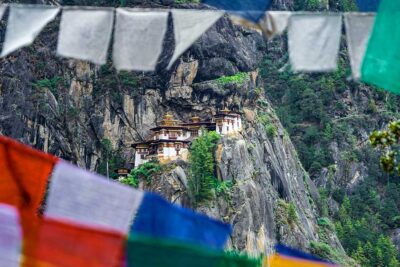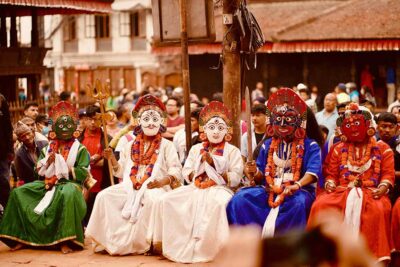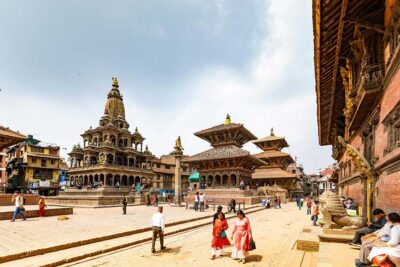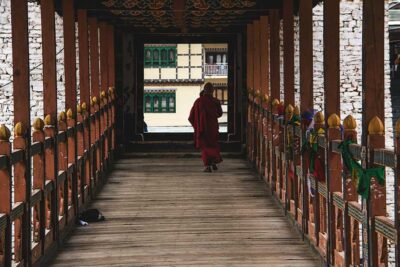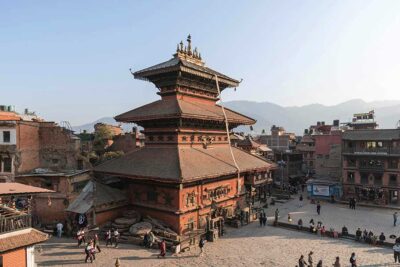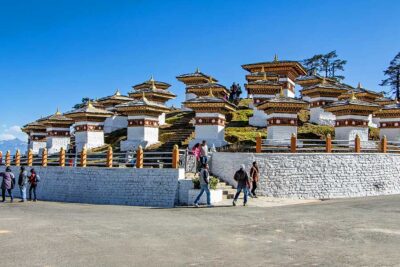Nepal & Bhutan: the soul of the Himalayas
Trip to Nepal and Bhutan – 12 Days
A 12-day journey through sacred landscapes, hidden monasteries, and timeless traditions
This carefully designed 12-day itinerary invites travelers to immerse themselves in the spiritual essence, cultural richness, and natural splendor of two Himalayan kingdoms: Nepal and Bhutan. From the vibrant streets and sacred temples of Kathmandu to the serene monastic life in the Bhutanese highlands, each step offers an intimate encounter with centuries-old traditions, breathtaking mountain scenery, and the peaceful rhythm of Himalayan spirituality.
The journey begins in Nepal, a land where history, nature, and devotion converge. Ancient stupas and royal palaces rise in the heart of bustling Kathmandu, while the artistic legacy of Patan and the mystical aura of Swayambhunath and Boudhanath reveal the deep roots of Hindu and Buddhist beliefs. Travelers will explore the sacred city of Bhaktapur, hike along terraced hillsides to reach Namobuddha Monastery, and experience rural hospitality in the timeless village of Panauti. Whether observing an evening Aarati on the banks of the Bagmati River or sharing a silent meal with monks, each moment in Nepal offers a sense of connection to something eternal and wise.
From the cultural depth of the Kathmandu Valley, the path leads into the green valleys of Bhutan — a country where happiness is a national philosophy and nature is revered as a spiritual presence. The Bhutanese leg begins in Thimphu, where ancient customs thrive alongside thoughtful modernization. Visitors will explore artistic institutions, engage with the teachings of Gross National Happiness, and hike to sacred sites like Cheri Monastery and Dochu-la Pass. In Punakha, the former royal capital, they will participate in rural life, traditional cooking, and restorative practices like the hot stone bath.
A truly immersive highlight awaits at Dodeydra Monastery, where guests will spend a day learning from monastic life, joining meditation sessions, and discovering the quiet depth of Bhutanese spiritual practice. The journey culminates in Paro with the ascent to the iconic Tiger’s Nest Monastery, a pilgrimage site suspended between earth and sky, and a final evening of reflection steeped in Bhutanese tradition.
From the prayer wheels of Boudhanath to the forest paths of Cheri, and from Namobuddha’s chants to the serene rituals of Dodeydra, this itinerary is not just a geographic crossing — it is a passage through inner worlds. A journey crafted to be not only witnessed, but deeply lived.
JOURNEY OVERVIEW AND PROGRAM DETAILS
1° DAY: ARRIVAL AT KATHMANDU
Kathmandu
Upon your arrival at Tribhuvan International Airport at Kathmandu, one of our representatives shall meet, assist and transfer you to your hotel. You will enjoy welcome drinks while you will be briefed about your Nepal Travel Itinerary. The rest of the day will be at your leisure.
Overnight in Kathmandu
2° DAY: HERITAGE SITES TOUR IN KATHMANDU
Kathmandu
After Breakfast start full day sightseeing at UNESCO Heritage sites; After breakfast drive to Patan, Sightseeing at Patan Durbar Square can be a very unique experience for visitors as they witness a distinct place for arts and architecture that is reflected on each temple, monument and palace building that were mostly built during the Malla period between the 16th to 18th centuries.
We will explore its unique Durbar Squares. In every corner & alley of Patan you can be see Thanka painters, filling color to ancient Gods and Goddess on canvases, fine metal shops that offer Buddha’s exotic, handmade brass sculpture at very reasonable prices. You can taste local cuisine as well in Patan’s alleys.
Then onward, the tour is headed towards Swayambhunath- A Monkey Temple from where you can see the magnificent views of Kathmandu Valley. The stupa, a tribute to Buddhism, consists of a dome at the base representing the entire world. Painted eyes of Buddha represent wisdom and compassion. A curly symbol, symbolizing the nose represents the unity of all things existing in the world. Prayer wheels surround the whole dome.
From there, the tour is directed towards Boudhanath. This is one of the UNESCO World Heritage sites and is one of the most imposing landmarks in Kathmandu. It is the largest stupa in the Kathmandu Valley. The 36-meter-high stupa of Boudha is massive and dominates the skyline in the area, it is one of the largest unique structures in the world. With countless monasteries around it, Boudha is the center of Tibetan Buddhism in Nepal. From above, Boudhanath Stupa looks like a giant mandala, or diagram of the Buddhist cosmos and as in all Tibetan mandalas, four of the Dhyani Buddhas mark the cardinal points, with the fifth, Vairocana, enshrined in the center (in the white hemisphere of the stupa).
In the evening drive to Pashupatinath Temple, a famous, sacred Hindu temple dedicated to lord Shiva is located on the banks of the Bagmati River. Dating back to the 5th century. While the main temple interior is off limits to non-Hindus there is a lot to experience in the surrounding area. Legend says that whoever comes here to worship Shiva will be reborn as an animal. Pashupatinath is a considerable complex of temples, ashrams, with images and inscriptions dating back centuries. A visit to Kumari Ghar is planned (if possible), the enchanting little palace which has been the home of the venerated “child goddess” for centuries. Believed to be the earthly incarnation of goddess Kali, the Kumari leaves her palace on rare occasions, where she is worshiped on the streets of the city. There will be an opportunity, if possible, to meet the Kumari.
Observe an Aarati (celebration with lights) at the Bank of Bagmati River. The “Aarati” at the banks of Bagmati River on the eastern side of the temple draws people in hordes. This evening ritual with chanting of Vedic mantras, ringing of bells, burning of incense, and lighting of oil lamps, a band singing hymns in praise of god, playing of classical instruments, keep the people spellbound throughout.
Overnight in Kathmandu (B)
3° DAY: HIKE TO NAMOBUDDHA
Kathmandu – Dhulikhel – Namobuddha
After Breakfast drive to Dhulikhel for 1 ½ hour and start our hike to Namobuddha: a 3–4-hour walk. On the hike you will enjoy breathtaking panoramic views of the mountains whilst passing many Buddhist Stupas on the Hilltops. Famous for farming rice, mustard and millet, during this hike you will walk through terraced farms. You will also come across many temples, different types of landscape and a rich diversity of the people living in harmony. Once we arrive at the monastery, we can participate in a chanting program for around an hour. The opportunity to interact with monks & trying out monastic food is a truly a unique experience.
Overnight in the monastery. (B).
4° DAY: HIKE TO PANAUTI
Namobuddha – Panauti – Bhaktapur ⎯ Kathmandhu
After Breakfast hike down to the beautiful historic town of Panauti, that permeates with an ancient ambiance. Here you can witness first-hand, the authentic village life of the Nepali people, you can also socialize with the villagers of Panauti and breathe the fresh air of the lush Panauti Valley. In Panauti we will have traditional lunch hosted by local community members who are charming and welcoming people. We then drive to Bhaktapur, a living museum of medieval art and architecture, is a unique old town famously known as the “city of devotees” as this landmark has a great influence over religion, culture and tantricism. It is a collection of pagoda and Shikhara-style temples assembled around a fifty-five-window palace of brick and wood. The durbar square is one of the most charming architectural showpieces. Pottery: Enjoy a leisurely guided walk at the Pottery square, where handicrafts are still made in a traditional way. Clay pots are spun and fired in the ancient ways preserving Bhaktapur’s thriving tradecraft. You can indulge and fashion a clay pot and learn about this fascinating process.
Overnight in Katmandhu (B, L)
5° DAY: TRANSFER TO PARO
Katmandhu – Paro – Thimphu
After breakfast, transfer to Kathmandu airport for your international flight to Paro. During the journey, if weather permits, you will enjoy panoramic views of the Himalayan range, including some of the world’s highest peaks. Upon arrival at Paro International Airport, you will be welcomed by our local representative and transferred to Thimphu, the capital city of Bhutan. The drive takes approximately one hour and follows the course of the Paro and Thimphu rivers.
After hotel check-in and lunch, the afternoon is dedicated to the first visits in Thimphu. You will begin with the Buddha Dordenma, one of the largest sitting Buddha statues in the world, followed by the Memorial Chorten, built in memory of the third King of Bhutan. You will also visit the nearby enclosure of the national animal, the Takin.
Later, you will visit the Choki Traditional Art School (CTAS), where underprivileged youth are trained in Bhutanese artistic traditions such as thangka painting, sculpture, embroidery and wood carving. If classes are in session, there will be an opportunity to interact with students and observe their work.
In the late afternoon, a meeting with local experts will offer insight into the country’s development model based on Gross National Happiness (GNH), a concept that integrates spiritual, environmental and social well-being.
Evening at leisure.
Overnight in Thimphu (B/L/D)
6° DAY: HIKE TO CHERI MONASTERY
Thimphu
After breakfast you will hike to Cheri Goemba Monastery. Drive 30 minutes to Dodena and hike about 45 minutes through beautiful forest trails to Cheri Monastery built in 1620. Cheri Monastery Hike gives you an insight into the natural discovery of Himalayan vegetation. The hiking trail passes through the off-beaten forest where one often gets to spot a variety of birdlife. The hike to this very scenic monastery is steep but relatively short, with several sacred sites scattered throughout the lush forest. Along the way there is a good chance of encountering wild animals (monkeys, deer…). Cheri monastery is one of the main retreat centres and a popular pilgrimage site in the country. Cheri Gompa was founded by Ngawang Namgyal, the Rinpoche who unified Bhutan as one political and spiritual entity. Its main function is as a retreat centre for the Drukpa Kagyu school of Vajrayana Buddhism. You can see a beautiful painting of Guru on the solid rock. Picnic lunch will be served near the riverbank near wooden bridge. After lunch visit Pangri Zampa Astrological college where if you are interested, you can meet with an astrologer for a consultation.
Overnight in Thimphu (B/L/D)
7° DAY: TRANSFER TO PUNAKHA VIA DOCHULA PASS
Thimphu ⎯ Punankha
After breakfast drive to Punakha (around 2 hrs) on a black topped smooth Road. Enjoy a breath-taking mountain view along the way. Arriving at Dochu-la, a pass at 3140 metres, have a short break to drink a hot tea or coffee while breathing in the fresh air of the high mountains and, if the skies are clear, admire the immense snow-capped peaks of the High Himalayas as we walk among the 108 chorten that decorate it. After a comfortable and spectacular descent (Bhutan’s roads are paved and well maintained), we will reach a small traditional restaurant for lunch, after we will take a walk-through rice field until we reach the Chimi Lhakhang. This temple was founded by Drukpa Kunley, the famous and beloved holy folk of Bhutan, a beautiful man and tantric master extraordinaire who used every means to bring his disciples to very high levels of contemplative realisation. After visit at the majestic Punakha Dzong, built between 1637 and 1638 at the confluence of Pho Chhu and Mo Chhu rivers.
Overnight in Punakha (B/L/D).
8° DAY: FARMHOUSE EXPERIENCE IN PUNAKHA
Punakha
After breakfast you will start exploring Punakha valley culture and traditions. We will drive to Nubgange village. Here you can engage in the farmhouse activities, such as, darts, archery and field work. Here you will have to have a cooking demonstration while preparing your lunch. Later hike down through villages with its quaint farming activities and the rural life in general. You can view the magnificent Punakha Dzong from this hike. Later you can enjoy a hot stone bath (optional).
Overnight in Punakha (B/L/D).
9° DAY: A DAY IN A MONASTIC LIFE
Punakha – Monastero di Dodeydra
After breakfast Transfer towards hike to Dodeydra monastery. If you love nature, tranquillity, butterflies, and the off beaten track then Dodeydra hike has a lot to offer. This beautiful and easy hike takes you to a hidden land, providing a hiker a sense of awe and wonder and a point of self-reflection along the way. The name Dodeydra has been derived from the split rock from where the Ter (Hidden Treasure) in the form of scripture was discovered. The monastery is beautifully built between the split rock, and it has two altars and beautiful paintings on the wall. The monastery also houses a small museum with many historic and religious artifacts and stories attributed to one of the Chief Abbot Jamyang Gyeltshen, considered an acclaimed craftsman who made numerous statues and paintings/murals. There are around 175 monks living here so today you will have a chance to learn how Buddhism is practiced in Bhutan. In the afternoon you will attend a meditation session on Samtha or vipassana. At 6:30 pm you can join the monks for the evening prayer.
Overnight in the Monastery guest house or in a camp site (B/L/D).
10° DAY: DEPART FROM PARO
Dodeydra – Paro
Early morning you can participate in morning prayer from 5:30 AM to 6:15Am. After breakfast hike to Jungzhina . Then by car continuing to Paro and check-in the hotel. After some rest visit the Kychu Lhakhang (temple). This is one of the oldest and most sacred shrines of Bhutan. The inner temple was built by a Buddhist Tibetan King, Srongtsen Goempo in the 7th century. Visit Paro Dzong, the 17th century fortress. The Dzong is the seat of the district administration as well as the home for the monastic school. The central tower (Utse) of the Dzong, with its superb woodwork, is one of the most beautiful in the country. Evening walk around Paro town
Overnight in Paro (B/L/D)
11° DAY: HIKE TO TIGER’S NEST MONASTERY
Paro
After breakfast start the day with short drive to Paro’s upper valley. On a clear day you’ll have an unforgettable view of the “Goddess” Mt. Chomolhari at 23,640 feet. Afterward, it’s a short drive to Taksang trail head. Hike to Taksang Monastery, the most famous monastery in Bhutan. Taksang means “Tiger Nest” so named because Guru Rinpoche reportedly flew to the site on the back of a flying tiger late in the 7th century. Between blue pines and a blue sky, the monastery perches miraculously on a cliff nearly 2,700feet above Paro’s valley floor. Offer butter lamp here. Have lunch at Takshang Café. Later visit a farmhouse where you will be able to see various Bhutanese traditional way of making rice wine, the Zaw, the Suja making (butter tea), learn traditional game of Archery and Degor (play with stone). Evening Enjoy a traditional hot stone bath. Back to hotel for a well-earned rest.
Overnight in Paro (B/L/D).
12° DAY: DEPARTURE FROM PARO
Paro ⎯ Aeroporto
Morning after breakfast you will transfer to the airport. Say goodbye to Bhutan and board a flight for onward destinations.
ACTIVITIES
- Visita ai siti patrimonio UNESCO della Valle di Kathmandu
- Escursioni panoramiche tra villaggi himalayani e terrazzamenti agricoli
- Esplorazione del cuore spirituale del Nepal nei templi di Boudhanath e Pashupatinath
- Partecipazione a programmi di canto rituale e condivisione di pasti monastici con i monaci buddhisti
- Scoperta della città antica di Bhaktapur, nota come la “Città dei Devoti”
- Esperienza di vita autentica nei villaggi con pranzo tradizionale a Panauti
- Apprendimento dell’arte della ceramica nella storica Piazza dei Vasai di Bhaktapur
- Attività nella giungla e osservazione della fauna selvatica nel Parco Nazionale di Chitwan
- Attraversamento del panoramico Dochu-la Pass con vista sulle vette himalayane
- Visit majestic Dzongs such as Punakha and Paro Fortress.
- Discover Bhutan’s national identity through Gross National Happiness seminars.
- Hike to sacred monasteries such as Cheri Goemba and Dodeydra.
- Spend a day immersed in monastic life, learning Buddhist practices and meditation.
- Engage in cultural exchange and traditional games in rural Bhutanese villages.
- Learn local culinary traditions and enjoy home-cooked meals with farmers.
- Hike to the breathtaking Tiger’s Nest Monastery perched on a cliff.
- Participate in spiritual rituals such as butter lamp offerings and evening prayers.
- Unwind with traditional hot stone baths after immersive cultural days.
HOTELS
HOTEL CATEGORIES: SUPERIOR, HERITAGE AND MONASTRIES
We selected beautiful and traditional hotels with excellent facilities throughout the tour. During this experience, you will also have the possibility to stay overnight in 2 monasteries. All the accommodations have been selected carefully according to criteria of social and environmental impacts.
TRANSPORT
Private vehicles o mini-buses with AC according to the number of participants for all the itinerary. A flight (not included) is required from Kathmandu to Paro.
WHEN TO GO
October to December is the best time to visit both, as dry days make trekking easier and offer good visibility. Autumn (September-November) and spring (late February-mid-April) are also great seasons to trek in Nepal.


